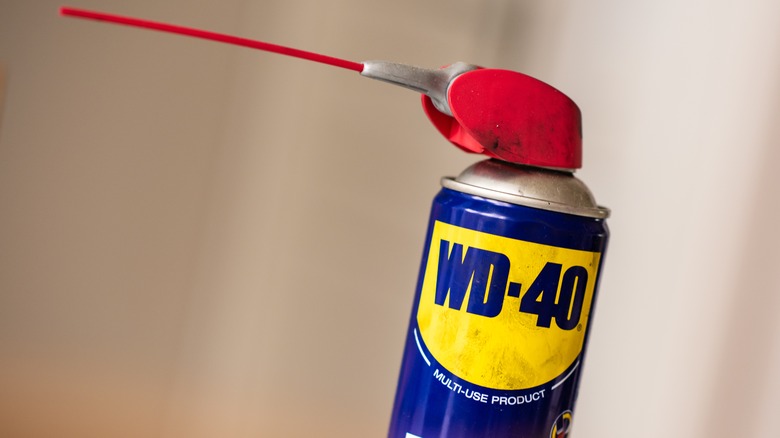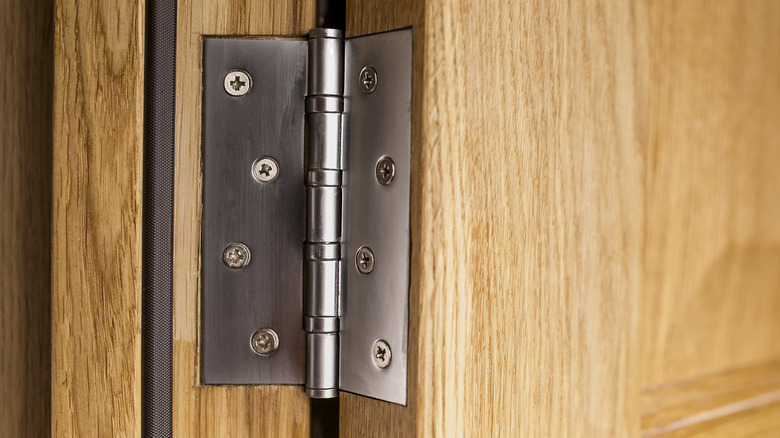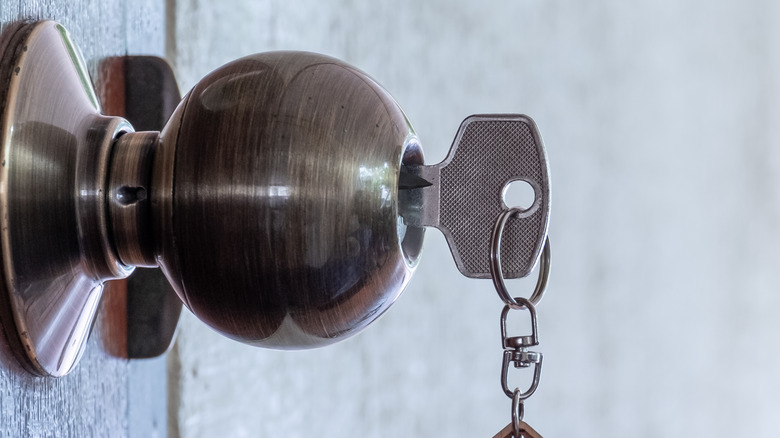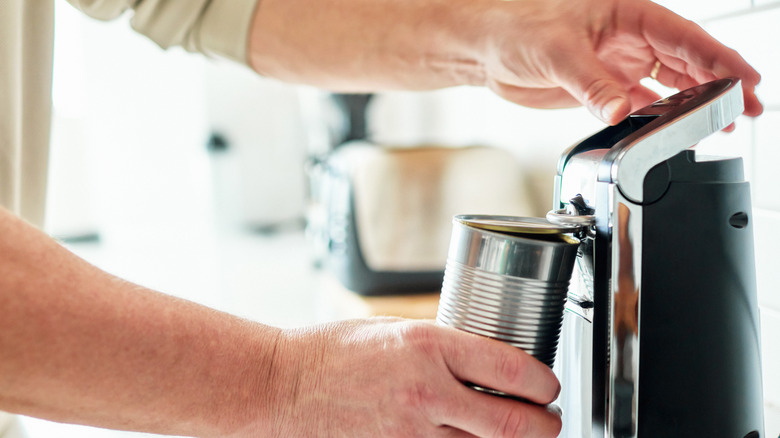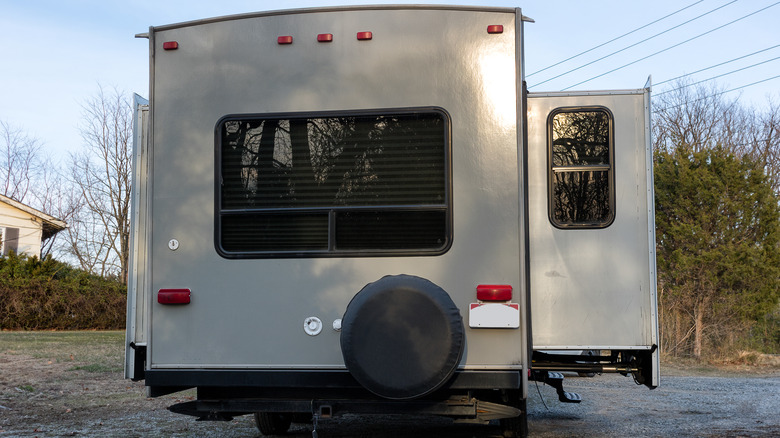Places That WD-40 Should Not Be Used (In And Around The Home)
We may receive a commission on purchases made from links.
People often say that you only need two things to fix issues around the house: duct tape to fix it if it moves and shouldn't or WD-40 if it should move but doesn't. However, the truth is a little more complicated. WD-40 does contain some lubricating agents, but these agents are dissolved within cleaning solvents. Although it can lubricate many things, WD-40 is often better as a cleaner and degreaser. Because of this, there are some places around the house where you shouldn't use it, and some of them are quite surprising.
The seemingly magical contents of the blue and yellow can are super handy for removing rust and crayon, and it's a great way to make sure snow slides easily off a shovel. But you shouldn't use it to grease up a squeaky hinge or free up a sticky lock. In fact, there are many places where WD-40 seems like a good idea but may not be the best fix.
Squeaky door hinges need more
While it may seem like a good way to squeak a sticky door, WD-40 shouldn't be used on hinges. A sticky hinge seems like a natural place to use the chemical, and a shot of WD-40 may stop the squeal for a little while. But, the lubricant in this particular product is suspended in cleansers, and there really isn't a lot of it. There simply isn't enough to work deep into the cracks in the hinge and lubricate it long-term. It can also attract dust and debris to your hinges, resulting in unattractive black streaks or marks. Ironically, WD-40 is a great way to clean away those black marks.
It's best to use a silicone spray for door hinges. Unless you have a complicated hinge that contains ball bearings, you should pop the pins out of the hinge, clean them thoroughly, and oil them liberally when reinstalling them. If you're dealing with a rusty hinge, use a penetrating lubricant like PB B'laster. You'll need quite a bit, so keep a rag handy for catching drips.
Don't gum up locks
A sticky lock is frustrating, and shooting a little lubrication into it can easily solve the problem. Unfortunately, WD-40 isn't the one to grab. It has the same issue in locks that it does in door hinges. The lubricating agents simply can't penetrate the lock to adequately loosen it or keep it free over time. They can also attract dirt and dust that will gum the lock up again. WD-40 is a powerful cleaner, as well. So, it will likely remove the necessary grease or oil in the lock but fail to adequately replace it.
A Teflon lubricant is one of the best options for keyed locks. This will lubricate the lock while remaining dry so it doesn't attract dust. It's also water-repellent, so rust shouldn't be a problem even if the lock gets wet or is exposed to high humidity levels, both of which can be common occurrences on exterior doors.
The bike chain debate
This one is the subject of some debate. Many, many websites claim that it's a bad idea to use WD-40 on bike chains as it could make dirt stick to the chain and gum it up again. The makers of WD-40 disagree, claiming that all is well if you wipe away any excess product after lubricating the chain. Bike experts and repair shops, however, seem to come down on the side of the internet and suggest that you avoid using WD-40 on your chain. They may recommend using it to clean a gunked-up chain but caution against using it as a lubricant.
If you're a fan, WD-40 does make a line of Specialist BIKE lubrication products you can buy from Amazon and safely use on your chain. Bicycle repair shops and riding gurus, however, often recommend and sell a very thin Teflon oil like Tri-Flow. Go for the drip bottle rather than the aerosol so you don't accidentally lube anything you shouldn't.
Avoid contaminating your kitchen
Unless you are positive that you're using it on a portion of the appliance that won't come into contact with heat or food, this cleaner is best left out of the kitchen. You may think that WD-40 can safely clean microwave doors and other movable appliance parts. However, it is flammable and unsafe for consumption. So, it's much safer to skip cleaning with it than it is to assume you can adequately rinse all of the residue away.
This is noteworthy if you plan to use WD-40 to clean your tile and grout. It is quite effective at doing so and is especially useful on floors in kitchens and bathrooms. If you have a tile countertop in your kitchen, however, resist the urge to clean it with the chemical. Instead, mix two parts baking soda and one part water to make a cleaning paste. If the grout is stained, substitute white vinegar for the water.
If you need to loosen up a kitchen appliance, reach for a food-grade lubricant. You may need an oil or more of a grease depending on how stuck the item is. Lubrication Engineers makes both a food-safe oil in liquid or spray form for simple fixes. Or, for more stubborn issues, you can opt for Super Lube food-safe grease for a thicker application.
WD-40 and electronics don't mix
Have a button stuck on your video game controller? Or is there a key sticking on your laptop keyboard? Both of these problems have led people to reach for the WD-40, which is a bad idea when dealing with electronics and can void your warranty. The solvents in WD-40 can break down certain plastics, which makes it potentially dangerous for some casings. Electronics can also contain plastic parts inside that you can't see or easily replace, and you don't want to damage those either.
To clean sticky keys and electronic buttons or cases, dampen a soft cloth with a mix of 70% isopropyl alcohol and 30% water. Turn the device off and then clean it gently with the dampened cloth. Allow your electronics to dry completely before using them again. If you're dealing with a computer keyboard or something similar, some compressed air can help to dislodge crumbs or other debris that may be stuck beneath a key.
Clean wood with care
WD-40 is great for removing life's little mishaps like gum or crayon marks somewhere it shouldn't be. But, you'll want to think twice before using it on the woodwork or your favorite end table. It's just not a good way to clean wood furniture. Many wood surfaces are sealed with wax, and WD-40 can soften and dissolve these finishes. It can often be used on painted wood surfaces like your baseboards, but caution should be used here as well. It's best to test on an inconspicuous area before using it.
However, you can just clean wood using a soft cloth dampened with warm soapy water and then rinse it thoroughly. Take care not to saturate the piece. Use a second cloth to dry the wood and then finish up with a protective furniture polish like Pledge Restoring Oil. You can also remove gum from wood by freezing it for a few minutes with a bag of ice so it is easier to pry off with a putty knife or a similar dull blade. Then, make sure to thoroughly dry the area.
RV slide-out seals need something different
If your RV has a slide-out to expand the living space, it is surrounded by rubber seals that keep out wind and moisture. Proper lubrication ensures that these seals glide smoothly as the portion is pulled out and pushed in, preventing tearing and premature wear. WD-40 breaks down rubber, however, and is an oft-used choice for maintaining these seals. And once again, this particular lubricant can attract dirt and dust, which you're trying to keep out of your seals. These particles could tear your seals, which can be expensive to replace.
Many experts claim that plain old talcum powder is the best lubricant for RV slide-out seals. However, if you prefer a commercial lubricant, opt for a dry one to avoid any build-up. Instead of normal WD-40, you can order the manufacturer's Specialist Dry Lube on Amazon. Or, you can opt for one of the many commercially available products designed specifically for RV slide-outs.
Don't damage your treadmill belt
Even if it doesn't squeak, the extra effort required during your workout will let you know when it's time to lubricate the belt on your treadmill. Be it a regular treadmill or an under-the-desk model, you'll want to stay on top of routine maintenance. So, you'll be doing this chore once every 3 months or every 130 miles. When it's time, don't reach for the WD-40. As you're likely aware by now, WD-40 can damage rubber. You also don't want it to attract dirt to your workout equipment, and this is even more important with something that sits close to the floor. Pet hair, dust, and dirt are all pulled down to the floor by gravity, which is exactly where your treadmill belt spends its time.
According to experts like NordicTrack, the best lubricant for your treadmill belt is a Treadmill Silicone Spray designed for treadmill use. You can simply lift the belt slightly and spray your lubricant of choice beneath it. Work carefully, however. You don't want to accidentally spray the top of your treadmill belt, which could make it slippery and unsafe.
Natural stone is too porous
Because it's such a great cleaner, you may be tempted to use WD-40 to clean natural stone floors or countertops. Resist this urge. Using the product on stone can cause many of the same problems as using it on wood. Stone is porous and if it's unsealed, the cleaner can saturate it and cause permanent discoloration. If the stone is finished, it may have been sealed with some type of wax coating which the cleaning solvents may damage or eat through entirely.
To keep stone floors and counters clean, dry dust them with a dustmop or dry cloth at least every other day so that dust particles don't scratch them. You can also use a vacuum cleaner but make sure the wheels are not scuffed up enough to be abrasive and damage the stone. When it's time for a deeper clean, mop or wipe with warm water and stone cleaner or mild soap. Rinse the stone well when you're done and dry it using a soft cloth or mop rather than an abrasive one.
A fishy story
Rumor has it that many anglers swear by WD-40. The story goes that after spraying their lures and fish hooks with WD-40, fishermen catch the biggest fish of their lives. The supposed reason is that the lubricant contains fish oil and this attracts larger swimmers that eat other species. Unfortunately, this is a fishy story according to the makers of WD-40. The product does not contain fish oil and it's highly unlikely that any of its ingredients will attract a bite, although the exact formula for WD-40 remains a secret. This is all beside the point, however, as adding petroleum distillates like WD-40 to waterways is illegal under the Clean Water Act.
The best way to catch bigger fish is to do your research and understand your prey so you can develop a sound strategy for attracting them. As far as WD-40 is concerned, you can use it to help maintain your fishing road and reels. There is no legitimate reason to spray it on your fishing hooks and lures, however. Plus, plastic lures may be damaged by the lubricant depending on their composition.

